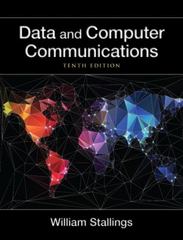When the sustained traffic through a packet-switching node exceeds the nodes capacity, the node must discard packets.
Question:
When the sustained traffic through a packet-switching node exceeds the node’s capacity, the node must discard packets. Buffers only defer the congestion problem;
they do not solve it. Consider the packet-switching network in Figure 20.13. Five stations attach to one of the network’s nodes. The node has a single link to the rest of the network with a normalized throughput capacity of C = 1.0. Senders 1 through 5 are sending at average sustained rates of ri of 0.1, 0.2, 0.3, 0.4, and 0.5 respectively.
Clearly the node is overloaded. To deal with the congestion, the node discards packets from sender i with a probability of pi.
a. Show the relationship among pi, ri, and C so that the rate of undiscarded packets does not exceed C.
The node establishes a discard policy by assigning values to the pi such that the relationship derived in part
(a) of this problem is satisfied. For each of the following policies, verify that the relationship is satisfied and describe in words the policy from the point of view of the senders.
b. p1 = 0.333; p2 = 0.333; p3 = 0.333; p4 = 0.333; p5 = 0.333
c. p1 = 0.091; p2 = 0.182; p3 = 0.273; p4 = 0.364; p5 = 0.455
d. p1 = 0.0; p2 = 0.0; p3 = 0.222; p4 = 0.417; p5 = 0.533
e. p1 = 0.0; p2 = 0.0; p3 = 0.0; p4 = 0.0; p5 = 1.0
Step by Step Answer:







